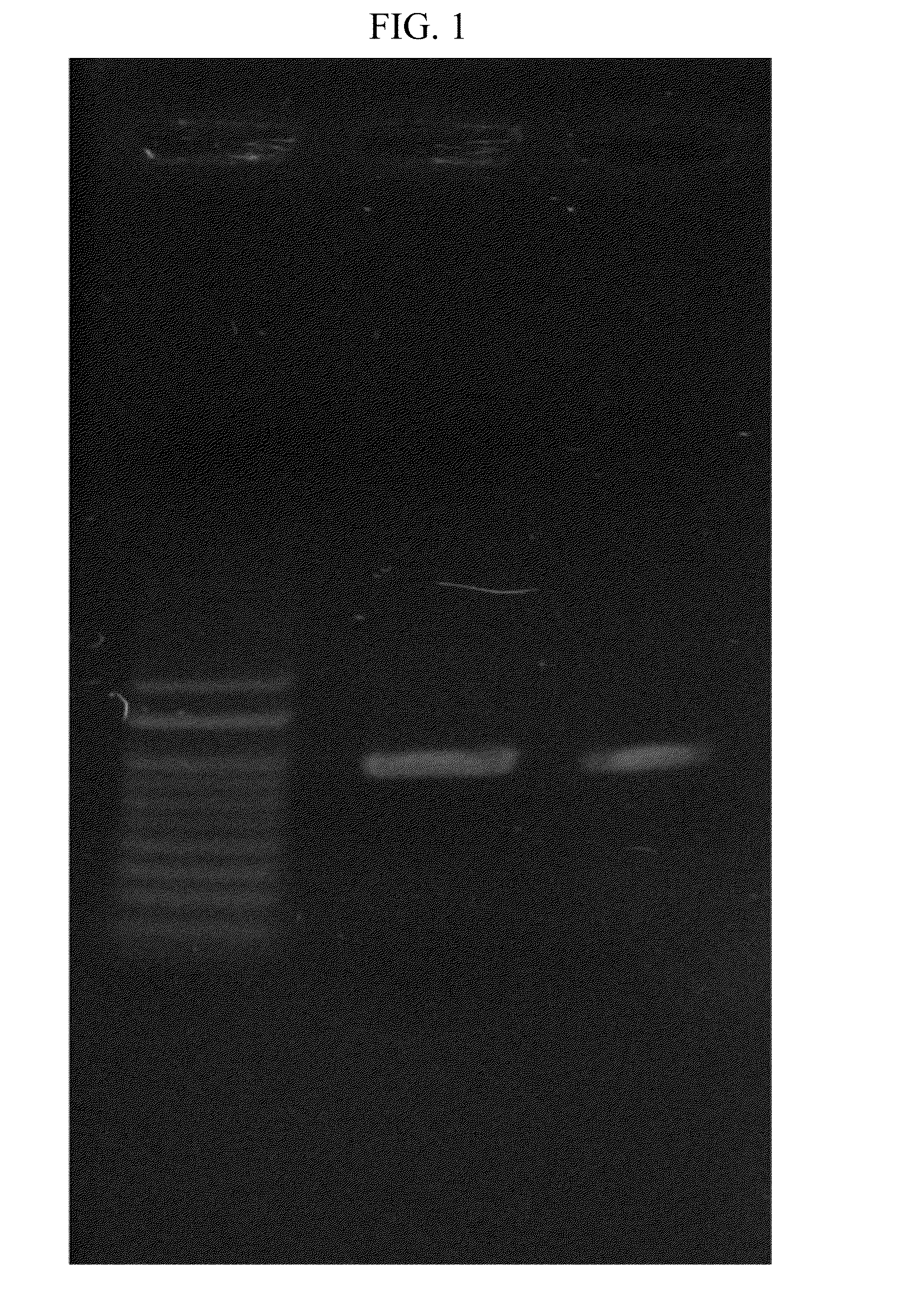Plant producing human enterokinase light chain protein and uses thereof
- Summary
- Abstract
- Description
- Claims
- Application Information
AI Technical Summary
Benefits of technology
Problems solved by technology
Method used
Image
Examples
example 1
Gene Synthesis
[0070]To the primer shEK-F1 (SEQ ID NO: 4) of Table 1, shEK-R1 (SEQ ID NO: 5), shEK-R2 (SEQ ID NO: 6), shEK-R3 (SEQ ID NO: 7), shEK-R4 (SEQ ID NO: 8), and shEK-R5 (SEQ ID NO: 9) were linked in order by a polymerization reaction. Also, to the primer shEK-F2 (SEQ ID NO: 10), shEK-R6 (SEQ ID NO: 11), shEK-R7 (SEQ ID NO: 12), shEK-R8 (SEQ ID NO: 13), shEK-R9 (SEQ ID NO: 14), and shEK-R10 (SEQ ID NO: 15) were linked in order by a polymerization reaction. Then, by a polymerization reaction of each fragment, the DNA fragment of 705 bp, which corresponds to a synthetic gene encoding the human enterokinase light chain protein with optimized rice codon, was obtained (SEQ ID NO: 1). It was then cloned into pGEM-T Easy vector and used for preparing pJKFEK which contains the synthesized gene encoding the human enterokinase light chain protein. As a result of determining the nucleotide sequence, correct synthesis was confirmed. For having extra-cellular secretion of the human entero...
example 2
Construction of Plant Expression Vector
[0071]pJKF3DEK was digested with the restriction enzymes BamHI and KpnI. After isolating by agarose gel electrophoresis the gene fragment encoding the human enterokinase light chain protein, which includes the secretion signal for rice alpha amylase 3D (RAmy3D) of 857 bp, it was introduced to the plant expression vector pMYN75 after digestion with the restriction enzymes BamHI and KpnI. As a result, the plant expression vector pJKF39 for producing the human enterokinase light chain (HEKL) protein was produced. Further, pJKF3DEKHis was digested with the restriction enzymes BamHI and KpnI. After isolating by agarose gel electrophoresis the gene fragment encoding the human enterokinase light chain protein, which includes the secretion signal for rice alpha amylase 3D (RAmy3D) of 877 bp, it was introduced to the plant expression vector pMYN75 obtained by digestion with the restriction enzymes BamHI and KpnI. As a result, the plant expression vector...
example 3
Transformation of Plant
[0072]pJKF39 and pJKF40 were introduced to rice callus by using PDS-1000 / He Biolistic Particle Delivery system of Bio-Rad Laboratories, Inc. and Agrobacterium transformation method. After the inoculating for 10 minutes the Agrobacterium tumefacience comprising the recombinant vector which has been produced to introduce the gene encoding enterokinase light chain protein to the rice callus, in vitro culture was performed for three days. After the in vitro culture, sub-culture was performed on a selection medium added with hygromycin. As a result, it was possible to confirm the normal growth of the callus. In addition, by using 67 lines in total including the plant transformed by gene gun method, the transformed pJKF39 line obtained by using (Agrobacterium) (pJKF39 a1˜9), the transformed pJKF39 line obtained by gene gun method (pJKF39 b1˜30), the transformed pJKF40 line obtained by using Agrobacterium (pJKF40 a1˜12), and the transformed pJKF40 line obtained by ge...
PUM
| Property | Measurement | Unit |
|---|---|---|
| Light | aaaaa | aaaaa |
Abstract
Description
Claims
Application Information
 Login to View More
Login to View More - R&D
- Intellectual Property
- Life Sciences
- Materials
- Tech Scout
- Unparalleled Data Quality
- Higher Quality Content
- 60% Fewer Hallucinations
Browse by: Latest US Patents, China's latest patents, Technical Efficacy Thesaurus, Application Domain, Technology Topic, Popular Technical Reports.
© 2025 PatSnap. All rights reserved.Legal|Privacy policy|Modern Slavery Act Transparency Statement|Sitemap|About US| Contact US: help@patsnap.com



